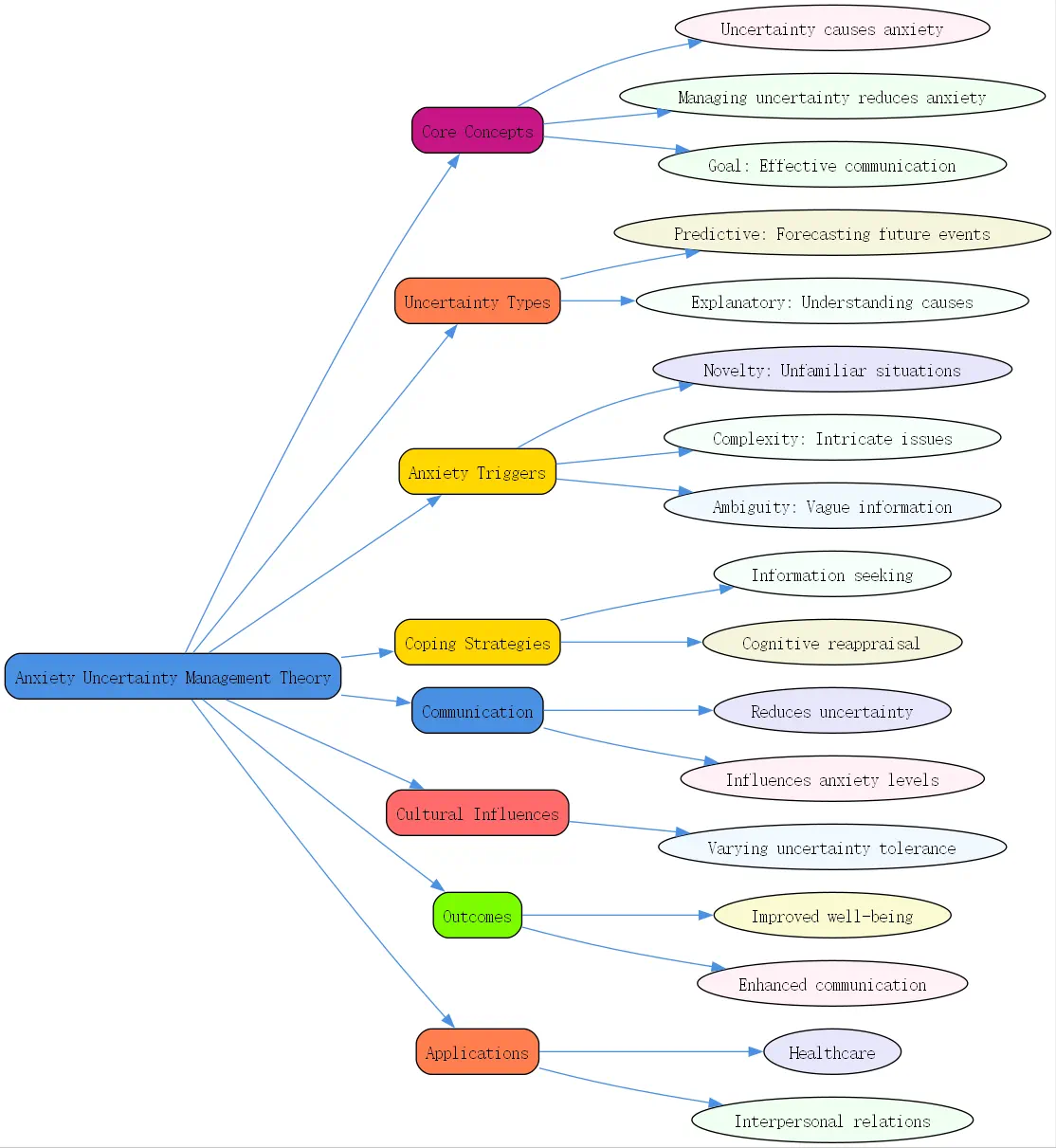Anxiety is a common human experience that can significantly impact our daily lives. For those grappling with persistent worry, catastrophizing thoughts, and physical symptoms like tension, sweating, or sleep problems, finding effective relief can be challenging. However, by understanding and applying the principles of anxiety uncertainty management theory, we can develop powerful strategies to not just calm anxiety, but to demolish it entirely. In this comprehensive guide, we’ll explore seven surprising tips that leverage this theory to help you regain control over your anxious thoughts and feelings.
Understanding Anxiety Uncertainty Management Theory
What is Anxiety Uncertainty Management Theory?
Anxiety uncertainty management theory, developed by communication scholar William Gudykunst, proposes that anxiety and uncertainty are fundamental causes of ineffective communication and social interaction. This theory suggests that by managing these two factors, individuals can improve their ability to communicate effectively and navigate social situations with greater ease.
The Role of Uncertainty in Anxiety
Uncertainty plays a crucial role in the development and maintenance of anxiety. When we face situations or outcomes that are unclear or unpredictable, our minds often fill in the gaps with worst-case scenarios, leading to increased anxiety. The anxiety uncertainty management theory posits that by learning to tolerate and manage uncertainty, we can significantly reduce our overall anxiety levels.
Core Principles of Anxiety Uncertainty Management
The core principles of anxiety uncertainty management theory revolve around developing strategies to increase our tolerance for ambiguity and reduce our need for certainty. This involves challenging our assumptions, embracing flexibility in our thinking, and learning to sit with uncomfortable feelings without immediately seeking resolution.
7 Surprising Tips to Demolish Anxiety: A Practical Guide
Now that we understand the foundation of anxiety uncertainty management theory, let’s explore seven counterintuitive yet highly effective techniques to manage and reduce anxiety. These tips, recommended by BrainTalking experts, may seem surprising at first, but they are grounded in solid psychological principles.
Tip 1: Identify and Label Anxiety Symptoms (Cognitive Diffusion)
The first step in managing anxiety is to recognize and name what you’re experiencing. This technique, known as cognitive diffusion, helps create distance between you and your anxious thoughts. When you notice anxiety creeping in, take a moment to identify exactly what you’re feeling. For example, you might say to yourself, “”I’m having an anxious thought about my upcoming presentation”” or “”I’m noticing that my hands are feeling jittery.””
Separating Yourself from Anxious Thoughts
By labeling your thoughts and sensations, you’re acknowledging them without becoming entangled in them. This simple act can help you realize that you are not your thoughts – you are the observer of your thoughts. This separation is a powerful first step in reducing the grip of anxiety.
Tip 2: Make a Decision to Be Non-Reactive to Anxiety
When anxiety strikes, our instinct is often to do something – anything – to make it go away. However, this approach can backfire, reinforcing the idea that anxiety is dangerous and must be eliminated immediately. Instead, make a conscious decision to be non-reactive to your anxiety.
Avoiding Immediate Relaxation Techniques During Anxiety
Contrary to popular belief, engaging in relaxation techniques or distractions the moment you feel anxious can actually reinforce anxiety in the long run. These actions send a message to your brain that anxiety is intolerable and must be escaped, which can make future anxiety episodes more intense.
Why Non-Reactivity Calms the Brain
By choosing not to react, you’re communicating to your brain that anxiety is not a threat. This non-reactive stance helps calm the amygdala, the part of the brain responsible for the fight-or-flight response, leading to a natural reduction in anxiety over time.
Tip 3: Change Your Overall Attitude Towards Anxiety
One of the most powerful shifts you can make is to change your overall attitude towards anxiety. Instead of viewing anxiety as an enemy to be defeated, try to see it as a normal part of the human experience – one that you can coexist with and even welcome.
Welcoming Anxiety Symptoms Instead of Avoiding Them
This may sound counterintuitive, but welcoming anxiety symptoms can be incredibly effective. The next time you feel anxious, try saying, “”Hello, anxiety. You’re welcome to stay as long as you’d like.”” This attitude of acceptance sends a powerful message to your brain that these sensations are not dangerous.
Retraining the Brain to Perceive Safety
By consistently demonstrating to your brain that you’re not afraid of anxiety symptoms, you begin to retrain your neural pathways. Over time, your brain learns that these sensations are not indicative of danger, leading to a reduction in the frequency and intensity of anxiety episodes.
Tip 4: Sing Your Worry Out Loud
This tip might make you chuckle, but that’s precisely the point. Singing your worries out loud to a familiar tune like “”Happy Birthday”” or even rapping them can have a surprisingly calming effect on your anxious mind.
Using Humor and Cognitive Diffusion to Calm the Brain
Singing or saying your worries in a funny voice is another form of cognitive diffusion. It helps create distance between you and your anxious thoughts, making them seem less serious and overwhelming. Plus, the act of singing or using humor can trigger the release of feel-good hormones, counteracting the stress response.
Tip 5: Cultivate an Attitude of Willingness (Psychological Flexibility)
Psychological flexibility is a cornerstone of mental health and a key component of anxiety uncertainty management theory. It involves being willing to experience discomfort if it means moving towards something you value.
Embracing Discomfort for Valued Activities

Instead of avoiding situations that make you anxious, practice being willing to feel uncomfortable for the sake of doing things that matter to you. This might mean giving a presentation despite feeling nervous or attending a social event even if it triggers some anxiety. By doing so, you’re expanding your comfort zone and building resilience.
Tip 6: The “”I AM”” Method (Incidental ERP)
The “”I AM”” method is a powerful technique that incorporates elements of Exposure and Response Prevention (ERP) therapy. It’s a simple yet effective way to manage anxious thoughts and sensations in the moment.
Identify: Recognize Anxious Thoughts or Sensations
Start by identifying what you’re experiencing. “”I’m having an anxious thought about my health”” or “”I’m noticing tension in my shoulders.””
Allow: Let the Thoughts Float Without Reaction
Allow the thought or sensation to be there without trying to change it or push it away. Imagine it floating like a cloud in the sky of your mind.
Moving On: Shift Attention to the Present Moment
Gently shift your attention to something in your immediate environment or a task at hand. This isn’t about distraction, but rather about engaging with the present moment while allowing the anxiety to be there in the background.
Tip 7: Stress Management Techniques as a Daily Lifestyle
While it’s important not to use relaxation techniques as an immediate reaction to anxiety, incorporating them into your daily routine can significantly improve your overall stress management and resilience.
Practicing Diaphragmatic Breathing, Meditation, and Exercise Regularly
Make stress-reduction practices like deep breathing, meditation, and regular exercise part of your daily life. These techniques, when practiced consistently, can help lower your baseline stress levels and improve your ability to cope with anxiety when it does arise.
Avoiding Stress Reduction Techniques as Immediate Reactions to Anxiety
Remember, the key is to practice these techniques regularly, not as a panicked response to anxiety. This approach helps build a foundation of calm and resilience, rather than reinforcing the idea that anxiety needs to be immediately “”fixed.””
Effective Anxiety Management Techniques PDF & Resources

To support your journey in managing anxiety, BrainTalking offers a downloadable PDF titled “”Why Do I Feel That in My Body?”” This resource provides valuable insights into the bodily symptoms associated with anxiety, stress, and panic, helping you better understand and manage your physical responses to anxiety.
Incorporating Daily Practices to Manage Stress and Anxiety
Developing a daily routine that incorporates stress management techniques is crucial for long-term anxiety relief. This might include setting aside time each day for mindfulness practices, engaging in regular physical activity, maintaining a balanced diet, and ensuring adequate sleep. Remember, consistency is key when it comes to managing anxiety and uncertainty.
Key Takeaways: Managing Anxiety with Acceptance and Non-Reactivity
- Identify and label anxiety symptoms to create distance from anxious thoughts
- Practice non-reactivity to anxiety to calm your brain’s alarm system
- Change your attitude towards anxiety, welcoming rather than fearing it
- Use humor and cognitive diffusion techniques like singing your worries
- Cultivate psychological flexibility by willingly facing uncomfortable situations
- Apply the “”I AM”” method for in-the-moment anxiety management
- Incorporate stress reduction techniques into your daily lifestyle, not as immediate reactions to anxiety

By applying these principles of anxiety uncertainty management theory and practicing these surprising yet effective techniques, you can develop a new relationship with anxiety – one where you’re in control, rather than being controlled by your anxious thoughts and feelings.
Q: How does anxiety uncertainty management theory differ from traditional anxiety management approaches?
A: Anxiety uncertainty management theory takes a unique approach by focusing on our relationship with uncertainty and how it contributes to anxiety. Unlike traditional methods that often emphasize immediate anxiety reduction techniques, this theory suggests that learning to tolerate and even embrace uncertainty can lead to more sustainable anxiety relief.

Traditional approaches might encourage using relaxation techniques or distraction methods as soon as anxiety arises. In contrast, anxiety uncertainty management theory proposes that these immediate reactions can reinforce the brain’s perception of anxiety as dangerous. Instead, it advocates for a non-reactive stance, allowing anxiety to be present without trying to change or eliminate it.
Moreover, this theory emphasizes the importance of psychological flexibility and willingness to experience discomfort, which can lead to personal growth and reduced anxiety in the long term. By changing our overall attitude towards anxiety and uncertainty, we can fundamentally alter our experience of these states, leading to more profound and lasting relief.




